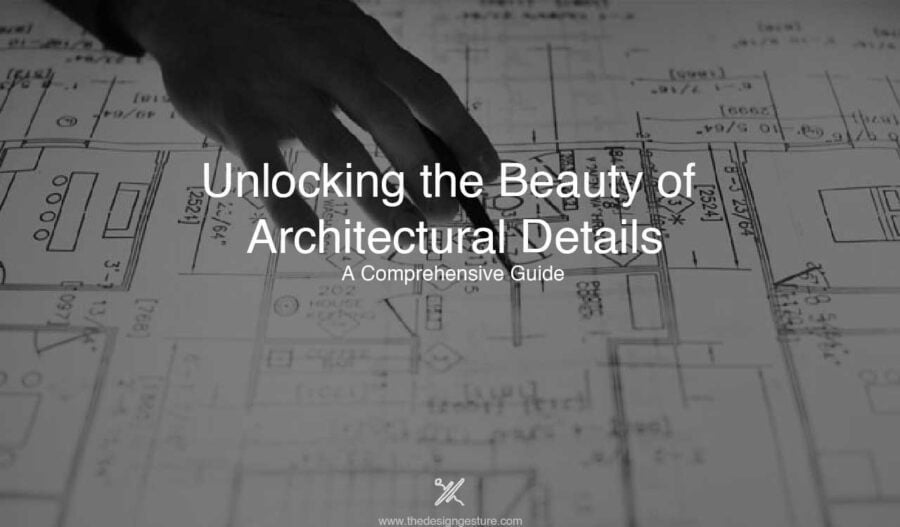Over the course of a building project, there are various components to how to design a structure, but one of the most important is an understanding of architectural detailing. Architectural detailing is used to highlight or merge parts with the rest of the architecture. We would almost likely see a lot of ‘ugliness’ in architecture without a professional supplying you with these deliberate approaches, such as ill-planned service ducts blocking your best vistas or walls that overlap window panes.
“The details are not the details. They make the design.”
- Charles Eames
It takes a lot of design, attention to details, and other factors to translate abstract ideas and aspirations into physical reality in architecture. But in addition to structural or technological aspects, visual features also have a role in how well aspirations are translated. The visual elements, which have more of an aesthetic appeal, are an integral component because they affect how rooms are seen as well.
Architectural detailing is precisely what it sounds like the practice of paying close attention to little details in the design of a space, both inside and out. Architectural detailing is classified into two types: structural detailing and design detailing.
Technical details are concerned with the functioning of a building and the assembly of its components; for example, technical detailing includes all of the designs and specifications that work to keep water out. Later, detailing is design detailing, which is just as exact and technical as technical detailing but focuses on building design features. Drawings of how different materials interact or resolve, or unique lighting details used to create a memorable moment, are examples of this.
Table of Contents
Structural (Technical) details: Bone of Design
A building’s primary function is performance. It must, among other things, keep the cold out, its occupants dry, the air fresh, the food cold, the faces out, and the noise from escaping. Good detailing plays a big role in achieving these performance objectives.
One of the most important areas of an architect’s job is understanding how insulation, due points, wiring, plumbing, structural components, and interior and external treatments will interact, hold up, and come together to make a structure. A significant portion of the design and pre-construction effort is spent coordinating the consultants and outlining the relationships between these many systems.
Design Details: Perception of Physicality
Simply ensuring that materials and their spaces are in equilibrium is a key aspect of architectural detailing. Many architects and designers have a natural eye for this; they can swiftly combine a variety of sizes, colors, materials, and textures in the architectural design that complements the space from a fast glance at a blank canvas of a room or vacant lot. When they’re finished, everything appears to be in perfect harmony and is quite aesthetically beautiful.
Each of these choices—there are hundreds or even thousands of them—requires careful consideration, which perfectly encapsulates the core of architectural detailing. Because of this, professionally designed spaces frequently appear smooth and exquisite, whereas DIY settings sometimes feel just a touch-off for no apparent reason. Understanding transitioning and material properties, along with the alignment of materials and geometry, is frequently the key. It takes time, thought, and numerous drawings to properly convey how the assembly will go together.
“The details are the very source of expression in architecture. But we are caught in a vice between art and the bottom line,” quoted Arthur Erickson.
Scope of Architectural Detailing
Architectural detailing is vast entity to look upon. It is not limited to the building materials, such as brick, wood, concrete, glass, or metal, and how they are treated or finished. The layout and positioning of windows, doors, and other openings. Columns, beams, arches, and the joints where these pieces meet are examples of structural elements. Interior design elements such as fixtures, fittings, and finishes such as paint, wallpaper, or molding. Cornices, friezes, and sculptures are examples of decorative and ornamental characteristics. The interaction of the building with its surroundings, including landscaping and outdoor area design.
The level of architectural detailing can have a considerable impact on the overall success of a design, as it affects both functionality and aesthetic appeal. Architects may create places that are coherent, harmonic, and interesting by carefully considering each aspect. These elements might also reveal information about the age, culture, or philosophy that impacted the design of the structure.
Architectural Details: Impact
Architectural elements have an impact on how we manage our time and help us create a sixth sense of the space around us in buildings. The exhibition of details through material elements elicits an emotional response that could be divisive across people, institutions, regions, countries, and potentially continents like the traditional styles, given that man makes decisions and records noteworthy events mostly in the subconscious. People select one style or choose to identify with one over another based on this choice.
It is possible to identify patterns in the composition of the architectural features, including material discontinuities, glue, connections fasteners, and interlocking. These particulars transform a problematic problem into a superbly completed area when they are accurately assessed and handled. Understanding architectural detail is the key to resolving building issues and obtaining insight into the built environment around us. Studying, learning, doing, trying, and failing are all limited by time and opportunity requirements for mastery.
A realization that the architect spent a significant amount of effort and competence on its creation and form. This concept is reflected in the breathability or sealed joinery of various materials, as well as its color palette, proportion, and visual presence. To support Edward’s thesis, the authenticity of materials, whether raw or treated, should be considered in architectural detail planning to examine and judge quality.
Architectural detail is what lies between the seen and hidden, shaping our connection with and knowledge of its notion. It articulates depth thoroughly, bringing us further to grasp, investigate, and enjoy the space envisioned around us, to understand why they fail or succeed as works of art. The surroundings of our lives are incomplete without architectural detail.




